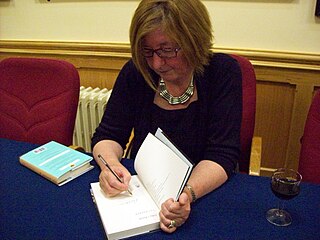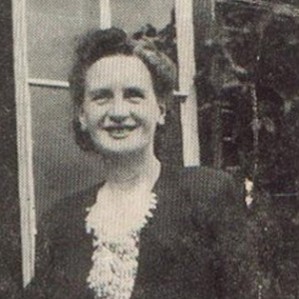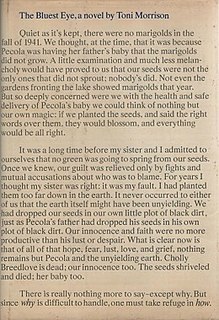
In ancient Greek mythology and religion, Persephone, also called Kore or Cora, is the daughter of Zeus and Demeter. She became the queen of the Underworld after her abduction by her uncle Hades, the god of the underworld.

Eleanor Alice Hibbert was an English writer of historical romances. She was a prolific writer who published several books a year in different literary genres, each genre under a different pen name: Jean Plaidy for fictionalized history of European royalty, Victoria Holt for gothic romances, and Philippa Carr for a multi-generational family saga. She also wrote light romances, crime novels, murder mysteries and thrillers under pseudonyms Eleanor Burford, Elbur Ford, Kathleen Kellow, Anna Percival, and Ellalice Tate.

Joyce Carol Oates is an American writer. Oates published her first book in 1963, and has since published 58 novels, a number of plays and novellas, and many volumes of short stories, poetry, and non-fiction. Her novels Black Water (1992), What I Lived For (1994), and Blonde (2000), and her short story collections The Wheel of Love (1970) and Lovely, Dark, Deep: Stories (2014) were each finalists for the Pulitzer Prize. She has won many awards for her writing, including the National Book Award, for her novel them (1969), two O. Henry Awards, the National Humanities Medal, and the Jerusalem Prize (2019).

Patricia Mary W. Barker, is an English writer and novelist. She has won many awards for her fiction, which centres on themes of memory, trauma, survival and recovery. Her work is described as direct, blunt and plainspoken. In 2012, The Observer named the Regeneration Trilogy as one of "The 10 best historical novels".

Ruby Constance Annie Ferguson, née Ashby, was an English writer of popular fiction, including children's literature, romances and mysteries as R. C. Ashby and Ruby Fergunson. She is best known today for her novel Lady Rose and Mrs. Memmary and her Jill books, a series of Pullein-Thompsonesque pony books for children and young adults.

The Bluest Eye, published in 1970, is the first novel written by Toni Morrison. The novel takes place in Lorain, Ohio, and tells the story of a young African-American girl named Pecola who grew up following the Great Depression. Set in 1941, the story is about how she is consistently regarded as "ugly" due to her mannerisms and dark skin. As a result, she develops an inferiority complex, which fuels her desire for the blue eyes she equates with "whiteness".
Emma Smith was an English novelist, who also wrote for children and published two volumes of autobiography. She gave encouragement to Laurie Lee while he was writing his bestselling memoir of his childhood, Cider with Rosie.

Dorothy Emily Stevenson was a best-selling Scottish author. She published more than 40 "light romantic novels" over a span of more than 40 years.

Penelope Ruth Mortimer was a Welsh-born English journalist, biographer, and novelist. Her semi-autobiographical novel The Pumpkin Eater (1962) was made into a 1964 film of the same name. It starred Anne Bancroft, who was nominated for the Academy Award for Best Actress for her performance as Jo Armitage, a character based on Mortimer herself.
Monica Furlong was a British author, journalist, and activist. She was born at Kenton near Harrow, north-west of London and died at Umberleigh in Devon. An obituary called her the Church of England's "most influential and creative layperson of the post-war period."
Persephone Books is an independent publisher based in Bath, England. Founded in 1999 by Nicola Beauman, Persephone Books reprints works largely by women writers of the late 19th and 20th century, though a few books by men are included. The catalogue includes fiction and non-fiction. Most books have a grey dustjacket and endpaper using a contemporaneous design, with a matching bookmark.
Jay Blakeney was a British writer and newspaper reporter, well known as a romance novelist under the pen names Anne Weale and Andrea Blake. She wrote over 88 books for Mills & Boon from 1955 to 2002. She died on 24 October 2007; at the time of her death she was writing her autobiography, 88 Heroes…1 Mr Right.

Dorothy Whipple was an English writer of popular fiction and children's books. Her work gained popularity between the world wars and again in the 2000s.
Eleanor Lucy Hoult, known by her pen name as Norah Hoult was an Irish writer of novels and short stories. A prolific writer, Hoult wrote twenty-three novels and four short story collections. Her work deals primarily with themes of alcohol abuse, prostitution, class dynamics and ill-fated marriages. Between the 1940s and 50s, Hoult's work was frequently banned by the Irish Censorship Board.
Isobel Dixon is a South African poet.
Phebe Gibbes was an 18th-century English novelist and early feminist. She authored twenty-two books between 1764 and 1790, and is best known for the novels The History of Mr. Francis Clive (1764), The Fruitless Repentance; or, the History of Miss Kitty Le Fever (1769), and The History of Miss Eliza Musgrove (1769). She received recent attention with the scholarly publication of Hartly House Calcutta (1789) in 2007.

Namita Gokhale is an Indian writer, editor, festival director, and publisher. Her debut novel, Paro: Dreams of Passion was released in 1984, and she has since written fiction and nonfiction, and edited nonfiction collections. She conceptualized and hosted the Doordarshan show Kitaabnama: Books and Beyond and is a founder and co-director of the Jaipur Literature Festival. She won the 2021 Sahitya Akademi Award.
June Guesdon Braybrooke, better known by her pen name Isobel English, was an English writer. Her best-known novel is Every Eye. Fellow writer Stevie Smith called her tone "a voice of our times, ironical and involved".
Helen Rosaline Ashton Jordan was a British novelist, literary biographer and physician.
Barbara K Hodges (1893–1949) was an English novelist who wrote under the pseudonym Elizabeth Cambridge. The daughter of Dr H. W. Webber, she was born in Rickmansworth in Hertfordshire. She spent her childhood in Plymouth and Westgate-on-Sea, and then attended Les Marrioniers finishing school in Paris. Barbara published her first set of short stories at the age of 17.










